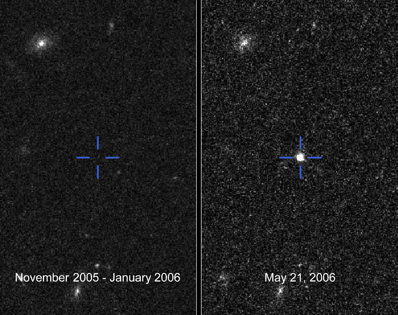|

Top Stories

|

|
 |
 |



Big planet, small star
...One of the smallest stars in the Galaxy has been found to have a planet orbiting it that is six times more massive than Jupiter. The discovery was made using a brand new technique that watches for wobbles in a star's proper motion...
read more
On the edge of a hungry black hole
...Gas and dust equal to the mass of two Earths are being gobbled up every hour by a hungry black hole in a distant galaxy, according to a space telescope probing the Universe in X-rays that has peered closer to a black hole than ever before...
read more
M82's hidden supernova
...A supernova has recently exploded in the nearby galaxy M82, but you won't be able to see it with any ordinary telescope. Shrouded in obscuring gas and dust, only the radio emission of the stellar explosion was seen...
read more
|
 |
 |

|
Spaceflight Now +

|

|
 |
 |

Subscribe to Spaceflight Now Plus for access to our extensive video collections!
 How do I sign up? How do I sign up?
 Video archive Video archive

STS-120 day 2 highlights

Flight Day 2 of Discovery's mission focused on heat shield inspections. This movie shows the day's highlights.

 Play Play

STS-120 day 1 highlights

The highlights from shuttle Discovery's launch day are packaged into this movie.

 Play Play

STS-118: Highlights

The STS-118 crew, including Barbara Morgan, narrates its mission highlights film and answers questions in this post-flight presentation.

 Full presentation Full presentation
 Mission film Mission film

STS-120: Rollout to pad

Space shuttle Discovery rolls out of the Vehicle Assembly Building and travels to launch pad 39A for its STS-120 mission.

 Play Play

Dawn leaves Earth

NASA's Dawn space probe launches aboard a Delta 2-Heavy rocket from Cape Canaveral to explore two worlds in the asteroid belt.

 Full coverage Full coverage

Dawn: Launch preview

These briefings preview the launch and science objectives of NASA's Dawn asteroid orbiter.

 Launch | Science Launch | Science

 Become a subscriber Become a subscriber
 More video More video

|
 |
 |

|
|
 |

Mysterious supernova may have carbon origins
BY KEITH COOPER
ASTRONOMY NOW
Posted: 2 June, 2009
A weird explosion in space that confounded astronomers may have been the destruction of a rare star with an unusual amount of carbon dust surrounding it, according to research carried out by scientists at the University of Warwick.
The explosion, which was first spotted on 21 February 2006 during a survey of a galaxy cluster in the constellation of Boötes by the Supernova Cosmology Project at the Lawrence Berkeley National Laboratory, has perplexed astronomers. Normal supernovae usually take around three weeks to reach peak brightness; this object, designated SCP 06F6, took 100 days to rise to magnitude +21, before taking another hundred days to fade away. Normal supernovae tend to have more asymmetric light curves than that. Furthermore, the European Space Agency’s XMM-Newton spacecraft spotted a bright X-ray glow coming from SCP 06F6, and yet no host galaxy has ever been identified. Even the distance to SCP 06F6 has been uncertain, because astronomers have been unable to decode the spectrum of the explosion, until now.

Before and after comparison pictures of SCP 06F6 taken by the Hubble Space Telescope.
Image: NASA/ESA/K Barbary (University of California, Berkeley).
A team led by Dr Boris Gaensicke and including Dr Andrew Levan, Professor Thomas Marsh and Dr Peter Wheatley, all from Warwick, think that whatever exploded was living in a thick shell of carbon dust, about two billion light years away. This would match up with the redshifted lines in the spectrum. “The optical light emitted at peak brightness came from a cool carbon-rich atmosphere, resembling the spectrum of a carbon star,” Dr Gaensicke told Astronomy Now. However, it couldn’t have been a fully-fledged carbon star, as typical carbon stars are not massive enough to explode as supernovae. Rather, Gaensicke’s team think that it may have been a massive star that went supernova inside a thick cloud of carbon-rich dust, similar to the environments found around some Wolf–Rayet stars.
“A thick circumstellar layer would explain the long time scale of SCP 06F6, and could help explain the large X-ray luminosity,” says Dr Gaensicke.
A number of other ideas to try and explain SCP 06F6 have been put forward over the last three years, including asteroids or even a white dwarf being destroyed and swallowed by a black hole. The lack of any visible host galaxy would suggest that it is extremely faint and without an active black hole at its centre, which would seem to rule those alternative theories out.
“Several new telescopes are now being designed and built that will continuously monitor the entire sky for short guest appearances of new stars,” says Gaensicke, whose research is published in the 1 June issue of Astrophysical Journal Letters. “There is no doubt that SCP 06F6 will not remain alone in puzzling astronomers over the coming years.”
|
 |
 |
 |
|
|



